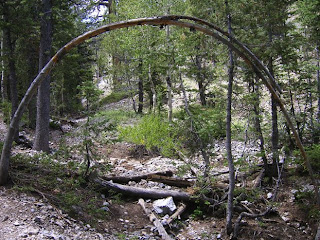Monday, September 22, 2008
hikingforums.net
Tuesday, September 9, 2008
Bristle cone Trail-Mt. Charleston, NV
Bristlecone Trail
LENGTH: 5.2 miles round trip
ELEVATION: 8,470 feet to 9,380 feet
USE: Hiking, pack & saddle, biking
ABOUT THE HIKE:
- The beginning of the Upper Bristlecone Trail winds through a picturesque forest abundant with fir and large quaking aspen. As you climb out of the canyon, the vegetation becomes sparser due to harsher conditions and shorter growing season found on these more exposed slopes. It is here that you reach the rugged, stands of ancient Bristlecone pines.
- After two miles the trail widens and follows the abandoned WPA road. Follow this road for the remainder of the Bristlecone Trail.
- The route passes the junction with the Bonanza Trail then descends into a canyon as the Lower Bristlecone Trail. Stay on the abandoned road, pass through a small grove of aspen, and continue on until the roadbed ends at the lower Bristlecone trail head.
- Walk south up State Route 156 for ¾ mile to return to the upper parking lot of Lee Canyon Ski Area.
Upper Bristlecone Trail head
- Travel southwest on State Route 156 for 17 ¼ miles into Lee Canyon until the road dead ends in the upper most parking lot of the Lee Canyon Ski Area. The Upper Bristlecone Trail head is located on the west side of this lot.
- Head southwest on State Route 156 for 16 ½ miles into Lee Canyon . Turn right onto Scout Canyon Road 140 ft. north of the McWilliams Campground to reach the trail head. Ample parking is available at this trail head.
Wednesday, September 3, 2008

While looking for information for my blister prevention post, I came across a site called Hike Hacker. It has some great tips on hiking for the new comer and the seasoned hiker. As a matter of fact I got one of my blister prevention ideas from them. They have many other good articles as well.
http://www.hikehacker.com/

Tuesday, September 2, 2008
How to Prevent Blisters
First we have to take a look at what a blister is, and what causes it.
according to http://en.wikipedia.org/wiki/Blisters
A blister is a small pocket of fluid within the upper layers of the skin. Blisters can be filled with blood (known as blood blisters) or with pus (if they become infected). However, most blisters are filled with a clear fluid called serum. Serum is the part of the blood that remains after red blood cells and clotting agents have been removed.
A blister usually forms because the outer layer of the skin has become damaged. Fluid collects under the damaged layer of skin, cushioning the tissue underneath, protecting it from further damage and allowing it to heal.
A blood-blister usually forms when a small blood vessel close to the surface of the skin ruptures (breaks) and blood leaks into a tear between the layers of skin. This can happen if the skin is crushed, pinched or squeezed very tightly.
Blisters can also form as the result of certain medical conditions.
OK, so we know what a blister is, How do we get them.
Back to wiki, it says.
Causes
Blisters are usually caused by injury to the skin from heat or from friction, which creates a tear between the epidermis—the upper layer of the skin—and the layers beneath. When this happens, the surface of the skin remains intact, but is pushed outwards as serum seeps into the newly created space between the layers.
Short periods of intense rubbing can cause a blister, as can any rubbing of the skin continued long enough. Blisters are most common on the hands and feet, as these extremities are susceptible while walking, running, or performing repetitive motions. Blisters form more easily on moist skin than on dry or soaked skin, and are more common in warm conditions.
So in essence it is saying that hiking is probably the easiest way to get a blister. But, looking at the causes it is easy to find ways to prevent them.
- It says the main cause of blisters are friction.
- To minimize this you want to wear hiking boots that fit well. This will minimize any rubbing that your foot will be doing.
- You want to wear appropriate socks. The best sock I have found are Thorlo® you can purchase a pair at http://www.thorlo.com/hiking-socks.php
- You want to have good socks that wick moisture, Thorlo® once again.
- When possible wear well ventilated shoes.
- When you take breaks you want to take your shoes off in order to cool off and dry out your feet. Better yet take your socks off to dry and give your feet a little massage.
- If you are really prone to blisters you may want to wipe your feet down with a baby wipe in order to clean off any pieces of dirt. These can also cause blisters if they rub on your feet for a period of time.
You don't have to bring a whole roll of tape with you, you can just take a little bit and wrap it around your hiking pole or around something else that you normally carry with you.
If you have any other ideas on how to prevent blisters please post them.
Until next time, hope you enjoyed it.









